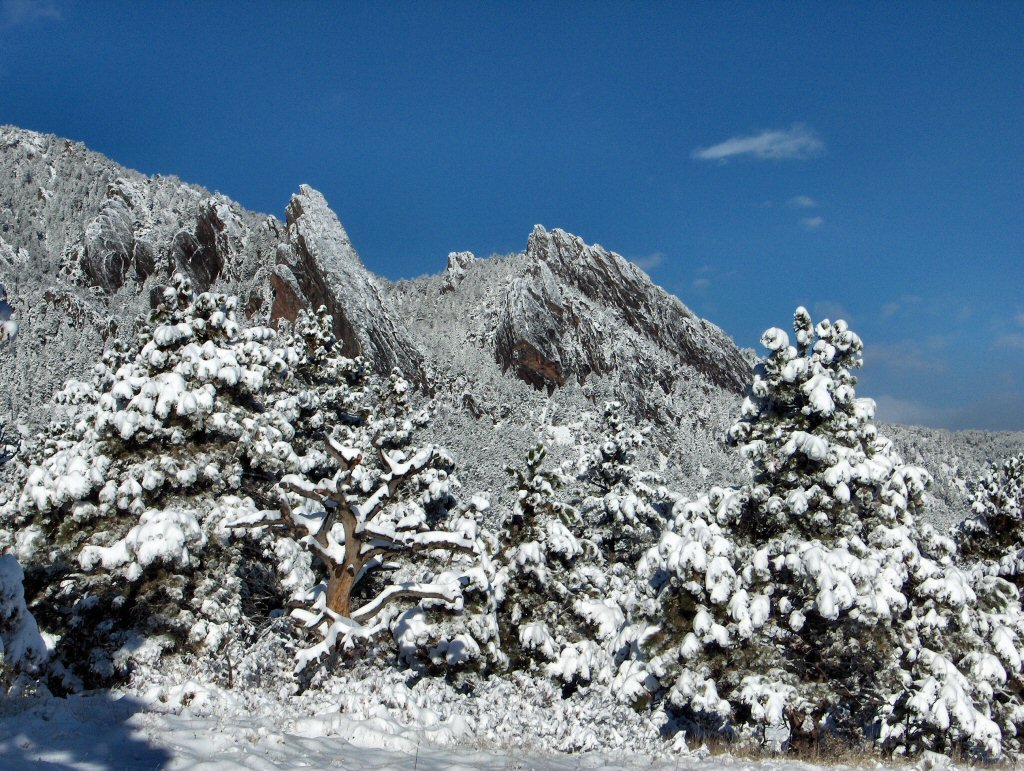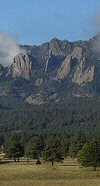City of Boulder Open Space and Mountain Parks Department
Analysis of Acquisitions and Trails: 1967-2007
by Peter Bakwin
(pbakwin@comcast.net, 303-589-6269)
31 May 2008
Three years ago the Boulder City Council passed the Visitor Master Plan for the Open Space and Mountain Parks Department (OSMP). What has happened since then? Where is Open Space headed? In order to have a background to address these questions, it is useful to understand what OSMP is today and how it has functioned in the past. Open space is the "crown jewel" of Boulder city government. People move here expressly for the access to open space for hiking, trail running, dog walking, bicycling, rock climbing, paragliding, horse riding, wildlife viewing and the unspoiled mountain backdrop. Open space is a huge economic engine for the city, driving everything from gear shops to a large fraction of the tourist business in town. There is no question that the program has been spectacularly popular and successful. Which is why OSMP is one of the largest departments in the city, with 85 employees and an annual budget of $22 million (from sales taxes).
From 1967 through 2007, OSMP spent $337 million (inflation adjusted to 2007) to acquire over 38,000 acres of land, and together with the original Mountain Parks (Open Space merged with Mountain Parks in 2001), OSMP has protected 45,000 acres. Including debt service, the city has spent well over $1 billion on open space acquisitions in the last 41 years.
The City Charter specifies a number of non-prioritized purposes for open space, which can be summarized as: habitat and resource protection, passive recreation, to control growth and limit sprawl, to maintain our agricultural heritage, and for floodplains. I looked at the 398 OSMP property transactions during 1967-2007 and determined whether or not each parcel is open and accessible to the public. Closed space consists of conservation easements (CE, including development rights), some agricultural lands, sensitive habitat from which visitors are excluded, and parcels that simply have no designated trail access. Currently, about half (48%) of all OSMP land is open and accessible to visitor access for passive recreation (this calculation assumes that 100% of the 6,399 acres of non-CE land that was transferred to OSMP from Mountain Parks in 2001 is open to visitor access).
My analysis shows that 91% of the land acquired in the first decade of the open space program (1967-1976) is open and accessible. Land acquired subsequently is increasingly inaccessible to the public: 51%, 29% and less than 4% of land acquired in the second (1977-1986), third (1987-1996), and fourth (1997-2006) decades of the program is currently open to visitors. This startling trend points to a major shift in the way open space is managed, and an undeniable movement away from the balance of open space uses that existed at the beginning of the program.
One factor (but definitely not the only one) in this shift is an increasing reliance on acquisition of conservation easements, as opposed to purchasing property in fee. Overall, about 11% all OSMP holdings (not including Caribou Ranch) are CEs, and this proportion is increasing (see figure).

Another way to address this trend is to look at the trails themselves. Unfortunately, OSMP does not have detailed records regarding when individual trails were built. So, to address the history of the trail network I looked at trail maps going back to the earliest OSMP map, which was published in 1987, as well as 1997 and 2002 paper maps, and also a spreadsheet containing detailed data on all current OSMP trail segments. Using this information it was possible to calculate the total mileage of designated trails for 1987, 1997, 2002 and the present.
In 1987 the city had about 22,500 acres of open space and 94 miles of trails, for a trail density of 2.7 miles of trail per square mile of land (see table below). Over the next 20 years OSMP doubled its land holdings, but added only 35 miles of designated trails. Many of these trails existed previously as undesignated, (“social”) trails, OSMP simply made them official. By 2007 the trail density had dropped to 2.0 miles per square mile. The highest density of trails has always been in the Mountain Parks areas, which I define as all OSMP lands west of Broadway between Eldorado Springs Drive and Linden Avenue. Many of these trails (such as the Mesa Trail) were established decades before the first open space sales tax initiative in 1967. Currently, the trail density in the Mountain Parks is 3.3 times that of the rest of the OSMP system. The Mountain Parks have 57% the trail miles on 29% of the total land area (Caribou Ranch, which is managed by Boulder County, is excluded from this analysis).
The table shows trail density in each year in units of miles of trail per square mile of land. Data are shown for the entire OSMP system, Mountain Parks only (MP), and outside of the Mountain Parks (OS).

Outside of the Mountain Parks, the density of trails built during the last 20 years (1987-2007) is 0.76 miles of trail added per square mile of land acquired, just 40% of that built during the first 20 years of the program (1967-1987). In these areas just 1 mile of trail has been added (designated) per year over the last 20 years! Assuming a trail construction cost of $15 per foot for the OS areas (which have generally gentle terrain), about $81,500 per year (2007 dollars) was spent to build trails in these areas. This is less than 1% of the amount spent on acquisitions (capitol only) during the same period (1987- 2007). Many of the trails added since 1987 are on properties acquired before that time, so the trail density on newer parcels is even lower. These facts bring up several questions: Is the trail density of the Mountain Parks too high? Was the density of trails built in during 1967-1987 too great? What is the reason for the shift away from providing trail access to our public lands?
It is useful to compare OSMP’s trail density to other parks and park systems. Some are listed in the table below. Individual parks, such as Horsetooth and Lory in Larimer County, South Mountain in Phoenix, and Mt. Tamalpais near San Francisco, are probably most comparable to OSMP’s contiguous Mountain Parks region. No doubt the managers of Horsetooth, Lory and Mt. Tamalpais, which have higher trail densities than our Mountain Parks, feel that their parks are being managed in a manner that is consistent with environmental protection. South Mountain receives 3 million visitors per year in an area 36% of OSMP, and with 45% of the trail miles of OSMP. Boulder’s OS areas, which are 71% of the total OSMP area, contain a trail density that is more comparable to Rocky Mountain National Park and the Indian Peaks Wilderness than to other near-urban parks.

Trail density is an objective metric that is easily expressed and comprehended, and is directly comparable to other park systems. One way that objectivity could be added to the TSA process is adoption of a trail density target for the entire OSMP system, with densities in the PRA, NA and HCA zones adjusted appropriately to achieve this overall value. This would greatly reduce the acrimonious nature of the debate over every potential trail project, as everyone would know that there are density standards to be met for the entire system. The work would become a matter of deciding how to allocate the allowed trail miles.
The dramatic drop in trail density has occurred during a time when area population and open space visitation have greatly increased. The result is inevitable: overcrowded trails, overflowing trailhead parking lots, damaged and eroded trails. Adding trails would dilute visitor impacts (fewer users per trail mile) and encourage visitors to say on designated trails. Resource damage is exacerbated by insufficient trail maintenance. For example, the department does not have a full-time trail maintenance crew. With more trails in currently underserved areas (especially, east of the city), and greater focus on maintenance, natural resources would be better protected while providing a high quality visitor experience.
The OSMP budget vastly favors acquisitions over trails. Currently, about $3.4 million is spent annually on acquisitions, $11 million for debt service, and just $450,000 for new visitor infrastructure, including trails and trailhead improvements. The budget is two-thirds acquisitions and just 2% for trails. The land acquired by OSMP is increasingly far flung and disconnected from existing holdings. Most of these parcels are acquired essentially for the sole purpose of stopping development. Further, land costs have soared: the average price per acre is now more than double what it was 20 years ago, in inflation-adjusted terms. During 1967-2007 OSMP spent an average of $8.2 million per year to acquire an average of 936 acres, so the current budget for acquisitions is about 40% of the 41-year average. In 2007, the city acquired the outlying 80.8-acre Stratton Property for $3.2 million. Hence, with current budgets and land costs, OSMP is now able to purchase less than 100 acres per year, about 10% of the 41-year average.
The analyses presented here show that Boulder’s OSMP program has shifted from a reasonable balance among the Charter purposes towards increasing limitation of visitor access. These days, few acquisitions are made with any realistic probability of allowing future access for recreational purposes. Trails are highly concentrated in the Mountain Parks areas west of the city, and trail density is decreasing overall, forcing visitors to utilize increasingly crowded trails. Unnecessary resource damage occurs because the department is focused (philosophically and via the budget) on acquisitions at the expense of maintenance and improvement of visitor infrastructure. Reversing these trends would be good for the City of Boulder, its citizens, and the Open Space program itself.
 7) If, notwithstanding our strong concerns with the merit of this acquisition, Council still believes the purchase is warranted, we note that the Shanahan property offers several opportunities for passive recreational values. According to the City Charter, recreation should receive equal consideration with the other values mentioned in the OSMP agenda packet. Specifically, we would like to see a trail around the northwest rim of the property, which would offer spectacular views of the mountains, valley and plains, and would provide a meaningful loop and connection of the existing trails from Greenbriar Blvd at Fairview High School to the South Boulder Creek trailhead on Hwy 93. We would also like to ensure that the Shanahan property will facilitate long-sought trail connections across Hwy 93 to the existing (but currently dead-ended) South Boulder Creek Trail (see map attached).
7) If, notwithstanding our strong concerns with the merit of this acquisition, Council still believes the purchase is warranted, we note that the Shanahan property offers several opportunities for passive recreational values. According to the City Charter, recreation should receive equal consideration with the other values mentioned in the OSMP agenda packet. Specifically, we would like to see a trail around the northwest rim of the property, which would offer spectacular views of the mountains, valley and plains, and would provide a meaningful loop and connection of the existing trails from Greenbriar Blvd at Fairview High School to the South Boulder Creek trailhead on Hwy 93. We would also like to ensure that the Shanahan property will facilitate long-sought trail connections across Hwy 93 to the existing (but currently dead-ended) South Boulder Creek Trail (see map attached).


















